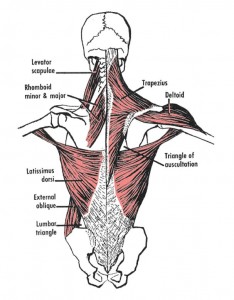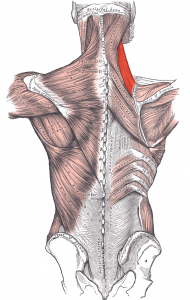The levator scapulae is an upper back and neck muscle that originates on the transverse processes of the first four cervical vertebrae (C1-4) and inserts on the superior angle of the shoulder blade, which is its uppermost point.
The levator scapulae influence the movement of both the shoulder blade and the spine.
The levator scapulae, along with several other muscles—traps, pecs, lats, and rhomboids—facilitate the elevation, abduction, and downward rotation of the shoulder blade.
As its name suggests, its main action is elevating the scapula—along with the trapezius muscle, the levator scapulae shrugs the shoulders, pulling up the inside edge of the shoulder blade.
It is also involved with rotating the cervical spine as it helps tilt and rotate the head to one side.
The head and neck should be able to rotate about ninety degrees and tilt around forty-five degrees to the side.
Unfortunately, there are so many ways to mess with levator scapulae.
The most obvious would be the everyday stress and tension of life which often manifests in elevated shoulders chronically contracting these muscles and leading to dysfunction.
Poor posture of many types often shortens the levator scapulae on both sides, while repetitive actions like always holding a phone between the same ear and shoulder or facing a computer monitor while looking down and to the side and what you are typing will affect one side (which, trust me, will come back to haunt the other side as well).
Levator scapula issues abound in the yoga practice but nowhere more than the transition from plank to chaturanga.
It doesn’t happen to everyone and it is not only levator scapulae involved but if your shoulders creep up towards your ears as you move in and out of chaturanga, levator scapulae will not be a happy muscle.
***



